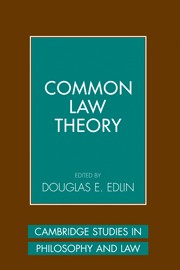Introduction
Published online by Cambridge University Press: 17 September 2009
Summary
The common law is today as fertile a source for theoretical inquiry as it has ever been. Around the English-speaking world, many scholars of law, philosophy, politics, and history study the theoretical foundations and applications of the common law. Nevertheless, these scholars too infrequently speak directly to one another, across jurisdictional or disciplinary boundaries. In an effort to foster that dialogue, and to frame and contribute to the discussion, this book is organized around certain classic common law concepts or themes: common law rules, common law reasoning, and common law constitutionalism. This thematic structure will help to emphasize the book's contributions to our understanding of the common law and to wider debates about rules, reasoning, and constitutionalism. At the same time, the division of this book into its three constituent parts should be understood as heuristically rather than hermetically motivated. Given the nature of theorizing about the common law, these themes inevitably and fruitfully overlap. Where the common law is concerned, it is difficult to write about rules without also writing about reasoning, and it is difficult to write about constitutionalism without also writing about rules. To theorize meaningfully about the common law, we need to see how these different concepts and domains of thought relate to one another. We need to see the wide-ranging theoretical and practical importance of the common law as a mode of legal thought, a body of legal doctrine, and a structural force in the relationships of governmental actors and institutions at a constitutional level.
Information
- Type
- Chapter
- Information
- Common Law Theory , pp. 1 - 24Publisher: Cambridge University PressPrint publication year: 2007
Accessibility standard: Unknown
Why this information is here
This section outlines the accessibility features of this content - including support for screen readers, full keyboard navigation and high-contrast display options. This may not be relevant for you.Accessibility Information
- 2
- Cited by
